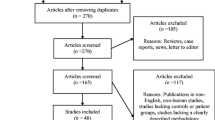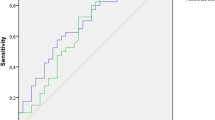Abstract
Purpose
This study utilized comprehensive salivary analysis to evaluate biochemical and immunological parameters in the saliva of oral squamous cell carcinoma (OSCC) patients.
Methods
Whole saliva was collected from 25 otherwise healthy OSCC patients and compared to 25 healthy, age- and gender-matched individuals. All OSCC lesions were located at the lateral aspect of the mobile tongue. The salivary parameters analyzed included: sodium (Na), potassium (K), calcium (Ca), inorganic phosphate (P), magnesium (Mg), total protein (TP), albumin (Alb), lactate dehydrogenase (LDH), amylase (Amy), total immunoglobulin G (IgG), secretory immunoglobulin A (Sec. IgA), epidermal growth factor, insulin growth factor I (IGF-I) and metalloproteinases MMP-2 and MMP-9.
Results
In cancer patients, salivary median total protein concentration was significantly higher by 26% (P = 0.01), as were concentrations of Na, Ca, P and Mg by 14% (P = 0.05), 59% (P = 0.05), 39% (P = 0.08) and 28% (P = 0.12), respectively. Amy and K concentrations were lower by 25% (P = 0.12) and 15% (P = 0.03), respectively. Alb was 108% higher (P = 0.0007), as were salivary LDH (88%, P = 0.002) and total IgG (125%, P = 0.01), while Sec. IgA was lower by 45% (P = 0.001). Concentrations of IGF, MMP-2 and MMP-9 were significantly higher by 117% (P = 0.03), 75% (P = 0.0003) and 35% (P = 0.05), respectively.
Conclusions
Comprehensive salivary analysis revealed an overall altered salivary composition in OSCC, indicating a compromised oral environment in these patients and suggesting salivary analysis as a new diagnostic tool for oral cancer. Local therapeutic agents can be easily applied to the oral mucosa, altering its “bathing medium”–the saliva.


Similar content being viewed by others
References
Adams TE, McKern NM, Ward CW (2004) Signalling by the type 1 insulin-like growth factor receptor: interplay with the epidermal growth factor receptor. Growth Factors 22(2):89–95
Baum JB, Costa PT, Izutsu TK (1989) Sodium handling by aging human parotid glands is inconsistent with a two-stage secretion model. Amer J Physiol 246:35–39
Bayes-Genis A, Conover CA, Schwartz RS (2000) The insulin-like growth factor axis: a review of atherosclerosis and restenosis. Circ Res 86(2):125–130
Ben Aryeh H, Jungerman T, Szargel R, Klein E, Laufer D (1996) Salivary flow-rate and composition in schizophrenic patients on clozapine: subjective reports and laboratory data. Biol Psychiatry 39:946–949
Fang J, Shing Y, Wiederschain D, Yan L, Butterfield C, Jackson G, Harper J, Tamvakopoulos G, Moses MA (2000) Matrix metalloproteinase-2 is required for the switch to the angiogenic phenotype in a tumor model. Proc Natl Acad Sci USA 97(8):3884–3889
Foulstone E, Prince S, Zaccheo O, Burns JL, Harper J, Jacobs C, Church D, Hassan AB (2005) Insulin-like growth factor ligands, receptors, and binding proteins in cancer. J Pathol 205(2):145–153
Hardt M, Witkowska HE, Webb S, Thomas LR, Dixon SE, Hall SC, Fisher SJ (2005) Assessing the effects of diurnal variation on the composition of human parotid saliva: quantitative analysis of native peptides using iTRAQ reagents. Anal Chem 77(15):4947–4954
Hohenwallner W, Stein W, Hafkenscheid JC, Kruse-Jarres JD, Kaiser C, Hubbuch A, KleinG (1989) Reference ranges for alpha-amylase in serum and urine with 4,6-ethylidene-(G7)-1-4-nitrophenyl-(G1)-alpha,D-maltoheptaoside as substrate. J Clin Chem Clin Biochem 27:97–101
Kantola S, Parikka M, Jokinen K, Hyrynkangs K, Soini Y, Alho OP, Salo T (2000) Prognostic factors in tongue cancer—relative importance of demographic, clinical and histopathological factors. Br J Cancer 83:614–619
Kuribayashi A, Kataoka K, Kurabayashi T, Miura M (2004) Evidence that basal activity, but not transactivation, of the epidermal growth factor receptor tyrosine kinase is required for insulin-like growth factor I-induced activation of extracellular signal-regulated kinase in oral carcinoma cells. Endocrinology 145(11):4976–4984
Liu SY, Lin MH, Yang SC, Huang GC, Chang L, Chang S, Yen CY, Chiang WF, Kuo YY, Chen LL, Lee CH, Liu YC (2005) Increased expression of matrix metalloproteinase-2 in oral cells after short-term stimulation and long-term usage of areca quid. J Formos Med Assoc 104(6):390–397
Mancini G, Carbonara AO, Heremans JF (1965) Immunochemical quantitation of antigens by single radial immunodiffusion. Immunochemistry 2:235–254
McQuibban GA, Gong JH, Tam EM, McCulloch CA, Clark-Lewis I, Overall CM (2000) Inflammation dampened by gelatinase A cleavage of monocyte chemoattractant protein-3. Science 289(5482):1202–1206
Myers JN, Elkins T, Roberts D, Byers RM (2000) Squamous cell carcinoma of the tongue in young adults: increasing incidence and factors that predict treatment outcomes. Otolaryngol Head Neck Surg 122:44–51
Nagler RM, Lischinsky S, Diamond E, Klein E, Reznick AZ (2001) New insights into salivary lactate dehydrogenase of human subjects. J Lab Clin Med 137:363–369
Nagler RM, Hershkovich O, Lischinsky S, Diamond E, Reznick AZ (2002a) Saliva analysis in the clinical setting: revisiting an underused diagnostic tool. J Investig Med 50(3):214–225
Nagler RM, Klein I, Zarzhevsky N, Drigues N, Reznick AZ (2002b) Characterization of the differentiated antioxidant profile of human saliva. Free Radic Biol Med 32:268–277
Nagler RM, Bahar G, Shpitzer T, Feinmesser R (2006) Concomitant analysis of salivary tumor markers—a new diagnostic tool for oral cancer. Clin Cancer Res 12(13):3979–3984
Pomerantz RG, Grandis JR (2004) The epidermal growth factor receptor signaling network in head and neck carcinogenesis and implications for targeted therapy. Semin Oncol 31(6):734–743
Renehan AG, Zwahlen M, Minder C, O’Dwyer ST, Shalet SM, Egger M (2004) Insulin-like growth factor (IGF)-I, IGF binding protein-3, and cancer risk: systematic review and meta-regression analysis. Lancet 363(9418):1346–1353
Reznick AZ, Hershkovich O, Nagler RM (2004) Saliva—a pivotal player in the pathogenesis of oropharyngeal cancer. Br J Cancer 91(1):111–118
Ribeiro KC, Kowalski LP, Latorre MR (2000) Impact of comorbidity, symptoms, and patients’ characteristics on the prognosis of oral carcinomas. Arch Otolaryngol Head Neck Surg 126:1079–1085
Seiwart TY, Cohen EE (2005) State-of-the-art management of locally advanced head and neck cancer. Br J Cancer 92(8):1341–1348
Wu HJ, Chi CW, Liu TY (2005) Effects of pH on nicotine-induced DNA damage and oxidative stress. J Toxicol Environ Health A 68(17–18):1511–1523
Zavras AI, Pitiphat W, Wu T, Cartsos V, Segas J, Lefantzis D, Joshipura K, Douglass CW, Diehl SR (2003) Insulin-like growth factor II receptor gene-167 genotype increases the risk of oral squamous cell carcinoma in humans. Cancer Res 63(2):296–297
Acknowledgment
The authors thank Mrs Gan for her assistance in the preparation of this paper.
Author information
Authors and Affiliations
Corresponding author
Rights and permissions
About this article
Cite this article
Shpitzer, T., Bahar, G., Feinmesser, R. et al. A comprehensive salivary analysis for oral cancer diagnosis. J Cancer Res Clin Oncol 133, 613–617 (2007). https://doi.org/10.1007/s00432-007-0207-z
Received:
Accepted:
Published:
Issue Date:
DOI: https://doi.org/10.1007/s00432-007-0207-z




